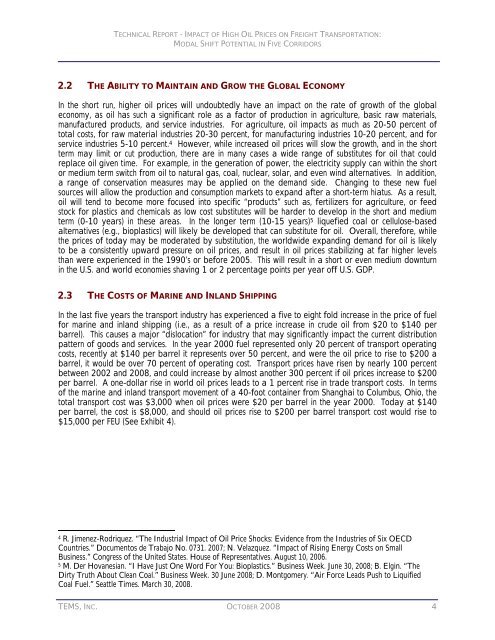impact of high oil prices on freight transportation: modal shift ...
impact of high oil prices on freight transportation: modal shift ...
impact of high oil prices on freight transportation: modal shift ...
Create successful ePaper yourself
Turn your PDF publications into a flip-book with our unique Google optimized e-Paper software.
TECHNICAL REPORT - IMPACT OF HIGH OIL PRICES ON FREIGHT TRANSPORTATION:<br />
MODAL SHIFT POTENTIAL IN FIVE CORRIDORS<br />
2.2 THE ABILITY TO MAINTAIN AND GROW THE GLOBAL ECONOMY<br />
In the short run, <str<strong>on</strong>g>high</str<strong>on</strong>g>er <str<strong>on</strong>g>oil</str<strong>on</strong>g> <str<strong>on</strong>g>prices</str<strong>on</strong>g> will undoubtedly have an <str<strong>on</strong>g>impact</str<strong>on</strong>g> <strong>on</strong> the rate <str<strong>on</strong>g>of</str<strong>on</strong>g> growth <str<strong>on</strong>g>of</str<strong>on</strong>g> the global<br />
ec<strong>on</strong>omy, as <str<strong>on</strong>g>oil</str<strong>on</strong>g> has such a significant role as a factor <str<strong>on</strong>g>of</str<strong>on</strong>g> producti<strong>on</strong> in agriculture, basic raw materials,<br />
manufactured products, and service industries. For agriculture, <str<strong>on</strong>g>oil</str<strong>on</strong>g> <str<strong>on</strong>g>impact</str<strong>on</strong>g>s as much as 20-50 percent <str<strong>on</strong>g>of</str<strong>on</strong>g><br />
total costs, for raw material industries 20-30 percent, for manufacturing industries 10-20 percent, and for<br />
service industries 5-10 percent. 4 However, while increased <str<strong>on</strong>g>oil</str<strong>on</strong>g> <str<strong>on</strong>g>prices</str<strong>on</strong>g> will slow the growth, and in the short<br />
term may limit or cut producti<strong>on</strong>, there are in many cases a wide range <str<strong>on</strong>g>of</str<strong>on</strong>g> substitutes for <str<strong>on</strong>g>oil</str<strong>on</strong>g> that could<br />
replace <str<strong>on</strong>g>oil</str<strong>on</strong>g> given time. For example, in the generati<strong>on</strong> <str<strong>on</strong>g>of</str<strong>on</strong>g> power, the electricity supply can within the short<br />
or medium term switch from <str<strong>on</strong>g>oil</str<strong>on</strong>g> to natural gas, coal, nuclear, solar, and even wind alternatives. In additi<strong>on</strong>,<br />
a range <str<strong>on</strong>g>of</str<strong>on</strong>g> c<strong>on</strong>servati<strong>on</strong> measures may be applied <strong>on</strong> the demand side. Changing to these new fuel<br />
sources will allow the producti<strong>on</strong> and c<strong>on</strong>sumpti<strong>on</strong> markets to expand after a short-term hiatus. As a result,<br />
<str<strong>on</strong>g>oil</str<strong>on</strong>g> will tend to become more focused into specific “products” such as, fertilizers for agriculture, or feed<br />
stock for plastics and chemicals as low cost substitutes will be harder to develop in the short and medium<br />
term (0-10 years) in these areas. In the l<strong>on</strong>ger term (10-15 years) 5 liquefied coal or cellulose-based<br />
alternatives (e.g., bioplastics) will likely be developed that can substitute for <str<strong>on</strong>g>oil</str<strong>on</strong>g>. Overall, therefore, while<br />
the <str<strong>on</strong>g>prices</str<strong>on</strong>g> <str<strong>on</strong>g>of</str<strong>on</strong>g> today may be moderated by substituti<strong>on</strong>, the worldwide expanding demand for <str<strong>on</strong>g>oil</str<strong>on</strong>g> is likely<br />
to be a c<strong>on</strong>sistently upward pressure <strong>on</strong> <str<strong>on</strong>g>oil</str<strong>on</strong>g> <str<strong>on</strong>g>prices</str<strong>on</strong>g>, and result in <str<strong>on</strong>g>oil</str<strong>on</strong>g> <str<strong>on</strong>g>prices</str<strong>on</strong>g> stabilizing at far <str<strong>on</strong>g>high</str<strong>on</strong>g>er levels<br />
than were experienced in the 1990’s or before 2005. This will result in a short or even medium downturn<br />
in the U.S. and world ec<strong>on</strong>omies shaving 1 or 2 percentage points per year <str<strong>on</strong>g>of</str<strong>on</strong>g>f U.S. GDP.<br />
2.3 THE COSTS OF MARINE AND INLAND SHIPPING<br />
In the last five years the transport industry has experienced a five to eight fold increase in the price <str<strong>on</strong>g>of</str<strong>on</strong>g> fuel<br />
for marine and inland shipping (i.e., as a result <str<strong>on</strong>g>of</str<strong>on</strong>g> a price increase in crude <str<strong>on</strong>g>oil</str<strong>on</strong>g> from $20 to $140 per<br />
barrel). This causes a major “dislocati<strong>on</strong>” for industry that may significantly <str<strong>on</strong>g>impact</str<strong>on</strong>g> the current distributi<strong>on</strong><br />
pattern <str<strong>on</strong>g>of</str<strong>on</strong>g> goods and services. In the year 2000 fuel represented <strong>on</strong>ly 20 percent <str<strong>on</strong>g>of</str<strong>on</strong>g> transport operating<br />
costs, recently at $140 per barrel it represents over 50 percent, and were the <str<strong>on</strong>g>oil</str<strong>on</strong>g> price to rise to $200 a<br />
barrel, it would be over 70 percent <str<strong>on</strong>g>of</str<strong>on</strong>g> operating cost. Transport <str<strong>on</strong>g>prices</str<strong>on</strong>g> have risen by nearly 100 percent<br />
between 2002 and 2008, and could increase by almost another 300 percent if <str<strong>on</strong>g>oil</str<strong>on</strong>g> <str<strong>on</strong>g>prices</str<strong>on</strong>g> increase to $200<br />
per barrel. A <strong>on</strong>e-dollar rise in world <str<strong>on</strong>g>oil</str<strong>on</strong>g> <str<strong>on</strong>g>prices</str<strong>on</strong>g> leads to a 1 percent rise in trade transport costs. In terms<br />
<str<strong>on</strong>g>of</str<strong>on</strong>g> the marine and inland transport movement <str<strong>on</strong>g>of</str<strong>on</strong>g> a 40-foot c<strong>on</strong>tainer from Shanghai to Columbus, Ohio, the<br />
total transport cost was $3,000 when <str<strong>on</strong>g>oil</str<strong>on</strong>g> <str<strong>on</strong>g>prices</str<strong>on</strong>g> were $20 per barrel in the year 2000. Today at $140<br />
per barrel, the cost is $8,000, and should <str<strong>on</strong>g>oil</str<strong>on</strong>g> <str<strong>on</strong>g>prices</str<strong>on</strong>g> rise to $200 per barrel transport cost would rise to<br />
$15,000 per FEU (See Exhibit 4).<br />
4 R. Jimenez-Rodriquez. “The Industrial Impact <str<strong>on</strong>g>of</str<strong>on</strong>g> Oil Price Shocks: Evidence from the Industries <str<strong>on</strong>g>of</str<strong>on</strong>g> Six OECD<br />
Countries.” Documentos de Trabajo No. 0731. 2007; N. Velazquez. “Impact <str<strong>on</strong>g>of</str<strong>on</strong>g> Rising Energy Costs <strong>on</strong> Small<br />
Business.” C<strong>on</strong>gress <str<strong>on</strong>g>of</str<strong>on</strong>g> the United States. House <str<strong>on</strong>g>of</str<strong>on</strong>g> Representatives. August 10, 2006.<br />
5 M. Der Hovanesian. “I Have Just One Word For You: Bioplastics.” Business Week. June 30, 2008; B. Elgin. “The<br />
Dirty Truth About Clean Coal.” Business Week. 30 June 2008; D. M<strong>on</strong>tgomery. “Air Force Leads Push to Liquified<br />
Coal Fuel.” Seattle Times. March 30, 2008.<br />
TEMS, INC. OCTOBER 2008<br />
4

















